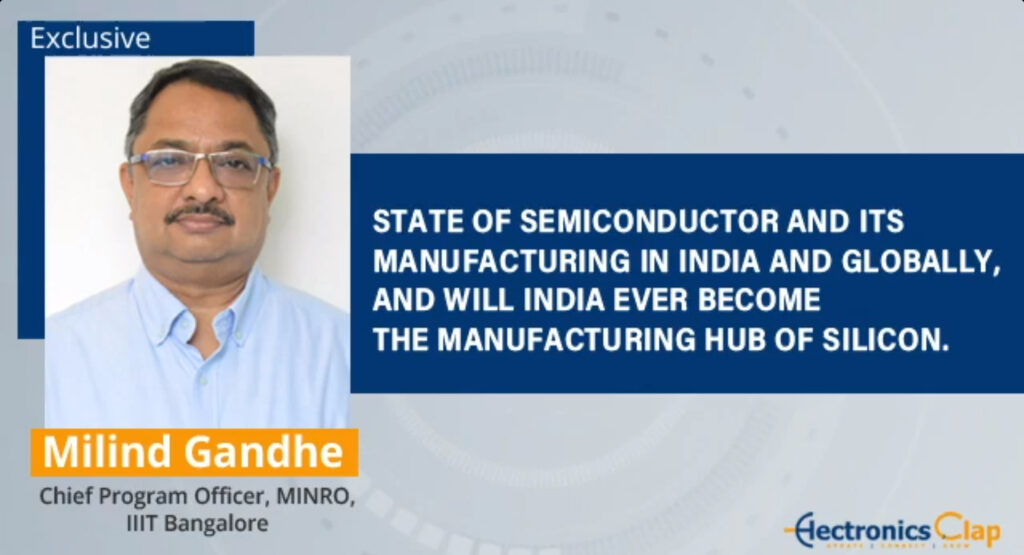
By Anamika Sahu, Editor-in-Chief
The world is facing a semiconductor crisis and there is still time to fill the gaps. There are several causes that led to this crisis, including local and global. So what went wrong, and how the auto industry misinterpreted the demand, is largely discussed with Milind Gandhe, the Chief Program Officer at MINRO at IIIT, Banglore.
Milind is an accomplished senior management professional who holds nearly 18 years of experience in embedded services, P&L management, product development, and more. He also has deep knowledge of technologies like protocol stacks, multimedia chip design, driver connectivity, and Android. He holds very strong know-how in the market such as handset, semiconductor, automotive, and consumer electronics.
Anamika: There is a sudden surge in the demand for electronic devices, which has resulted in the shortage of semiconductors globally. Do you think there are other reasons and factors leading to this shortage?
Milind: There are definitely multiple reasons including global and local reasons. One aspect, of course, is COVID. If you go back, maybe 15 months or so, people anticipated a significant drop in global shipments, particularly of cars. In 2019, there were probably 83 million cars sold worldwide and nearly 70 million were sold in 2020. There was a drop, indeed, in the automotive shipments.
But anticipating this drop, the car companies went ahead and canceled a lot of the orders. The automotive supply chain is extremely just in time. There is very little redundancy in the supply chain. And therefore, the supply chain is very sensitive to changes in demand. Hence a little bit of increase in demand leads to a strong push back, even in terms of supply. 15 months ago, car companies slashed their orders with the semiconductor companies, which left semiconductor companies with excess capacity.
Now, the good news for the semiconductor companies was that there were other sectors that were picking up, because there was a great move towards work from home. Sales particularly of devices such as mobile phones, and laptops went up. This kept the market more or less steady.
In Q1 of 2020, the global sales dropped from 350 million units to close to 200 million units. But in the next quarter, we were immediately back to the 330-340 million mark. So while their orders were being cut by the automotive companies, orders were growing with laptops, mobile phones, and servers, because as people started working from home, there was more and more demand on cloud services.
There was an overall change in the product mix. Semiconductor companies started allocating more of their manufacturing capacity to devices such as servers, laptops, and phones. Everything seemed to be okay until car companies realized that the car demand was not falling as much as they anticipated. H2 of 2020 was going to be more or less back on track to normal. We had close to 40 million units being sold in 2020, but suddenly automotive companies had a massive order and they started placing orders to the semiconductor companies. However, the semiconductor companies just didn’t have the capacity. This is a supply chain view.
Compounding this is the trade tension between US and China. Most modern chips are sub 10 nanometers, typically seven nanometers, especially in phones and laptops. Towards the end of 2019, the US said that companies based in the US cannot buy sub-10 nanometers chips from China, which means a lot of the production capacity went off demand, off of the supply chain, in parallel. Anticipating that there would be supply shortages because of this trade war, many companies started placing double orders.
There are also some very local factors playing out. Water is a very important component of silicon manufacturing. Taiwan the silicon center of the world, but it is facing a drought currently, which has restricted the growth of manufacturing capacity. Also, in February this year, there was a massive cold spell in Texas. Energy supply was hit, which impacted silicon production for almost three to four weeks.
Anamika: There are many reports saying the silicon shortage would last till 2023. What do you think about the shortage and how we are going to counter the shortage?
Milind: Not 2023, but the end of 2022 for certain because definitely, the demand has proven to be far more robust. There is a loose monetary policy globally, especially in the US. We do see very strong demand for the next two years. I would expect that demand to continue to outstrip supply.
But in India, there is little we can do. The kind of time horizons that we’re looking at, I don’t think there’s enough of a semiconductor industry in India today to deal with it.
According to me, there are three key factors that we should look at. One is TSMC who themselves have announced almost a two and a half billion dollar investment in the new fab, which will bring excess capacity in line in Taiwan. However, it will be interesting to see how they work through the drought. Next, the government of South Korea along with Samsung and SK Hynix have announced almost a $10 billion investment, of which some will definitely go to memory.
The third is the bipartisan bill that the US government passed and approves a very strong investment in semiconductor manufacturing in the US. We are going to see a little bit of a shift in terms of manufacturing capacity moving back into the US. Intel, as an example, has announced a $3.1 billion investment in a fab in Arizona. I expect more companies to invest similarly. US is now beginning to view silicon as a strategic asset and they are going to insist on more indigenous production capacity. TSMC is also looking at building some fabs in the US.
So to sum up, there three broad vectors – increased capacity in Taiwan, increased government and industrial investment in South Korea. And then the US trying to bring more and more capacity back into the US.
Anamika: What does this shortage mean for the automotive industry and how can they prepare to handle the crisis?
Milind: The automotive industry needs to rethink the value chain. For several decades now, the automotive industry has focused on lean manufacturing. But there is one lesson that the pandemic has taught us – lean manufacturing does not lead to resilient supply chains. So if you need resilience, then you need some buffers allocated in the supply chain.
The automotive industry has also just discovered, to its surprise, that they are not the gorilla in terms of purchasing power in the semiconductor market. For the semiconductor industry, computing and communications are two far more important verticals compared to automotive. Hence the automotive industry will increasingly build more in-house capacity in terms of fab. One such move was from Bosch who recently announced a $1.2 billion fab factory in Germany specifically for automotive needs. There will be more vertical integration in the automotive industry as far as silicon is concerned than we have seen in the past.
Anamika: In-house fab facility is one of the alternatives. Are there any other alternatives you can foresee?
Milind: To be honest, the quantity of silicon in the car is going to increase is a gimmick. If you look at what a car was, let’s say 10 or 15 years ago, it was largely electromechanical. It was basically mechanical engineering with very little of power electronics thrown in, there was very little computing. Today, a car is fundamentally a compute platform. The mechanical aspects of the car are almost like an add-on. This is a dramatic shift. The architecture could change, and I suspect it will change.
Today we probably have upwards of 100 microcontrollers in a high-end car. My suspicion is that the architecture could change when you move to more of a domain controller kind of architecture. So instead of having 100 tiny microcontrollers, we could move to four or five large compute platforms. We could have something that’s controlling driving, something controlling the body, another one controlling the transmission; something like four or five chips controlling the entire automotive.
Some amount of change in architecture could reduce demand in terms of volumes. But nonetheless, the silicon content in the car is not going to see a secular growth for the next 10 to 15 years at the very least. The car industry just needs to learn how to manage the silicon supply chain better.
Anamika: Are we looking at developing fab manufacturing capacity in India?
Milind: It’s little challenging. India also is now beginning to look at silicon as a strategic asset. And to that extent, there is definitely a governmental policy push to move more and more of manufacturing capability into India. But having said that, India is nowhere in the global silicon manufacturing chain. We are good users of silicon.
There are a couple of companies that are doing quite a bit in terms of assembly and test, such as Tesssolve, a Hero Group company, which is one of the leaders. But other than them, there is very little in terms of the assembly and manufacturing that happens in India. However, the point is, this is such a complex technology. These are such large projects that unless you gain knowledge incrementally and have enough funds, it’s going to be a challenge. It’s an interesting challenge that the Indian government and Indian industry have not been able to solve for the last 20 years.
Anamika: What are some of the other roadblocks or bottlenecks in the way of India becoming a fab hub?
There are many challenges, three of them being the key ones. One is the scarcity of power, the other scarcity of water. Silicon manufacturing is extremely power-intensive, as well as water-intensive. If we really want to see what India can do to become a significant manufacturing hub, we should look at the automotive industry. We often underplay automotive manufacturing capability; it’s not very well appreciated that India has a significant automotive manufacturing capacity built up. Almost 50% of India’s manufacturing base, actually, is automotive.
India is already 5% of the world market in terms of volumes. But our manufacturing is also export-oriented. It isn’t low-end cars for certain, but there is a significant manufacturing base. And that has happened in clusters, like Chennai, Sriperumbudur, Maraimalai Nagar, Pune, and a few in Haryana. There is a significant technology know-how impact that these clusters have. And we would do well by looking at some of these.
We can start with bringing in some electronics manufacturing capability into the incubating clusters that already have the know-how. More than the water & power shortage, what hurts India is the lack of expertise. Silicon manufacturing is enormously difficult, technically. Building that sort of know-how is not an overnight task. It’s a multi-year project.
Anamika: How can the country, the companies, the government, and the institutions like IIIT work together to help make India one and put India on the Global Silicon Map?
Milind: It’s important to identify individual processes. Silicon manufacturing is a multi-step process. Packaging, assembly, and the test could be a good way to take the first step. It may make sense to just start off by putting together package assembly and test plants and grow your practice. Post this we can look at backward integration and see how much of that capacity can be brought into the country.
There is definitely an opportunity in this space. But it’s a step-by-step process. It’s never going to happen by one big bang sort of capacity building.
